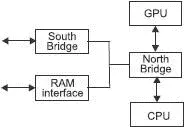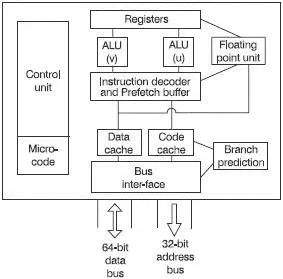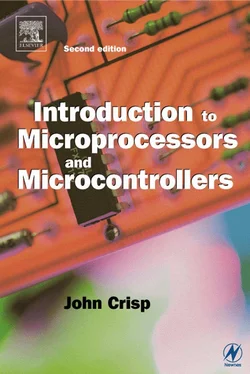John Crisp - Introduction to Microprocessors and Microcontrollers
Здесь есть возможность читать онлайн «John Crisp - Introduction to Microprocessors and Microcontrollers» весь текст электронной книги совершенно бесплатно (целиком полную версию без сокращений). В некоторых случаях можно слушать аудио, скачать через торрент в формате fb2 и присутствует краткое содержание. Год выпуска: 2004, ISBN: 2004, Издательство: Elsevier, Жанр: Компьютерное железо, на английском языке. Описание произведения, (предисловие) а так же отзывы посетителей доступны на портале библиотеки ЛибКат.
- Название:Introduction to Microprocessors and Microcontrollers
- Автор:
- Издательство:Elsevier
- Жанр:
- Год:2004
- ISBN:0-7506-5989-0
- Рейтинг книги:3 / 5. Голосов: 1
-
Избранное:Добавить в избранное
- Отзывы:
-
Ваша оценка:
- 60
- 1
- 2
- 3
- 4
- 5
Introduction to Microprocessors and Microcontrollers: краткое содержание, описание и аннотация
Предлагаем к чтению аннотацию, описание, краткое содержание или предисловие (зависит от того, что написал сам автор книги «Introduction to Microprocessors and Microcontrollers»). Если вы не нашли необходимую информацию о книге — напишите в комментариях, мы постараемся отыскать её.
Introduction to Microprocessors and Microcontrollers — читать онлайн бесплатно полную книгу (весь текст) целиком
Ниже представлен текст книги, разбитый по страницам. Система сохранения места последней прочитанной страницы, позволяет с удобством читать онлайн бесплатно книгу «Introduction to Microprocessors and Microcontrollers», без необходимости каждый раз заново искать на чём Вы остановились. Поставьте закладку, и сможете в любой момент перейти на страницу, на которой закончили чтение.
Интервал:
Закладка:
The Microsoft Xbox
The Xbox is the latest offering in this market. They have opted for the opposite strategy to the Playstation 2 by making the console fairly cheap but charging more for the games. Presumably, the name of Microsoft together with an attractive upfront price will mean the boxes are carried out the shops and we will worry about the games later. They seem to sell to an older group than the other two and perhaps the price of games may not be such a barrier.

Figure 11.11 The Xbox
The microprocessor chosen for this machine is the Pentium 3 running at 733 MHz. They have gone for a standard micro rather than a specialized design but even so, it has got such power that it can blast through a game at a good rate. The geometric drawing speed of textured polygons is 50 million per second or twice the speed on the PS2 or eight times that of the Gamecube. In all cases, the polygon count has texture included. The bare polygon is a simple wire-frame shape without any surface coloring which is essential to provide reality to the scene.
The North Bridge chip is the central block of the Xbox and provides interconnections between the other units. It controls access to the 64 MB memory that provides a cache for the use of the CPU (Central Processing Unit) to store program code and a larger share for the GPU (Graphics Processing Unit). The North Bridge also sends signals to the South Bridge chip.
The South Bridge provides all the external inputs and outputs via the USB and network ports together with the audio signals.
The GPU design shown in Figure 11.12 is called the ‘nVidia’ is based on the GeForce 3 design, another popular computer component. The graphic processor converts the CPU output into the finished information being sent to the CPU or television.

The Figure 11.12 The graphics chip
The information about each object on the screen such as its position, the lighting applied and the surface appearance is prepared together with two features that are used to decrease the computing power necessary or to improve the appearance with the same processor. The ‘pixel shader’ that can apply realistic lighting and surface texture effects over a whole scene without each individual point being calculated separately and the vertex program oversees the detailed changes that are necessary in critical areas. We tend to be very selective when it comes to details, we would notice the slightest change in a facial expression yet ignore whole leaves on a tree. By controlling light and texture characteristics, the vertex shader fills in details of these small but important changes.
In each case, choose the best option.
1 The ‘size’ of a microprocessor is determined by the:
(a) width of its data registers.
(b) number of lines in its external data bus.
(c) number of digits in its type number.
(d) width of its address registers.
2 An integrated circuit having 15 000 transistors is classed as a:
(a) LSI device.
(b) SLSI device.
(c) VLSI device.
(d) SSI device.
3 An untextured polygon:
(a) looks like a dinosaur.
(b) is just a wire-frame shape.
(c) has no shape.
(d) is a cube.
4 An L1 cache is usually:
(a) onboard the microprocessor.
(b) constructed from DRAM for maximum speed.
(c) slower than Level 2 cache.
(d) external to the microprocessor.
5 RISC:
(a) means ‘radical instruction set computer’.
(b) has longer instructions and is therefore slower than a CISC chip.
(c) is part of everyday life.
(d) chips employ a smaller instruction set.
12. The Pentium family
The Pentium is a 32-bit microprocessor just like the previous Intel 80386 and 80486 but has been considerably enhanced to improve its speed of operation. Even the 132 pins of the 80386 have increased to 296 on the Pentium.
Other full RISC chips were being well-received at the time the CISC Pentium was launched in 1993 and Intel took these new designs into account but it was boxed into a corner by its own success. It had to maintain absolute compatibility with the previous 8086, 80286, 80386 and the 80486 together with their numerical co-processors. The compromise was to use all the RISC while maintaining the CISC codes. It has over 400 instruction codes. Some are performed by hardware and some by microcode. Its two million plus transistors have been incorporated into a superscalar structure. This means that it has duplicated arithmetic and logic units that can allow it to carry out two instructions at the same time under favourable conditions.
It was launched at 66 MHz and in its first year became famous as the microprocessor that couldn’t count. There was a flurry of letters in the computer magazines and a host of ‘How many Pentiums does it take to change a light bulb?’ type jokes. At first, Intel denied there was a problem even though they must have known about it. ‘And, no, you can’t have your money back.’ More letters. ‘Alright, there is a very, very small matter of a few division sums.’ The error actually produced inaccuracies in the sixth or ninth decimal place in some particular division sums. This was insufficient error to affect more that a small minority of users but it started to undermine confidence in the Pentium. The real problem was that two errors occurred during its design at the same time. Either one, on its own, would have been spotted but the two mistakes served to hide each other. Anyway, it’s been fixed. It only affected the early versions and is no longer significant.
Over time the speed has increased to 200 MHz with the inevitable rumours of the Pentium II running at 400 MHz that will support a 100 MHz system clock.
See Figure 12.1.

Figure 12.1 The Pentium processor
Data and code caches
Connections to the outside world are via a 64-bit external data bus and a 32-bit address bus. The incoming data that consists of numerical data and instruction codes are loaded very quickly into two internal caches – an 8 kbyte data cache and an 8 kbyte code cache. These caches shift data very rapidly on the internal pathways that are 128 and 256 bits wide.
Whenever possible, the Pentium uses burst mode to read and write data. The burst mode system loads a cache for example, with more data than the width of the data bus. If a cache line is 128 bits wide and it is fed from a 64-bit data bus, then we could completely fill the line by transferring 64 bits and then another 64 bits. Burst mode loads all 128 bits very rapidly without further intervention from the microprocessor. Putting more new data into the cache will increase the chances of the cache holding the required information. This is called a cache ‘hit’.
Prefetch buffer
The prefetch buffer is a small internal memory that holds a list of instructions that are waiting to be executed. This ensures that the instruction decoder is never waiting for a new instruction from the external (slow) memory and it makes more efficient use of the external data bus since the new instructions can be loaded whenever the opportunity arises. When it gets a moment, the Pentium shifts an instruction from the external program into the cache and transfers one instruction from the cache into the prefetch buffer and also sends a signal to the microcode circuit to prepare the code for the next instruction. So, with all the housekeeping done, the instruction decoder can be fed with instructions and data at its maximum rate. The prefetch buffer is actually two independent 32-bit buffers, each providing input to one of the ALUs.
Читать дальшеИнтервал:
Закладка:
Похожие книги на «Introduction to Microprocessors and Microcontrollers»
Представляем Вашему вниманию похожие книги на «Introduction to Microprocessors and Microcontrollers» списком для выбора. Мы отобрали схожую по названию и смыслу литературу в надежде предоставить читателям больше вариантов отыскать новые, интересные, ещё непрочитанные произведения.
Обсуждение, отзывы о книге «Introduction to Microprocessors and Microcontrollers» и просто собственные мнения читателей. Оставьте ваши комментарии, напишите, что Вы думаете о произведении, его смысле или главных героях. Укажите что конкретно понравилось, а что нет, и почему Вы так считаете.












